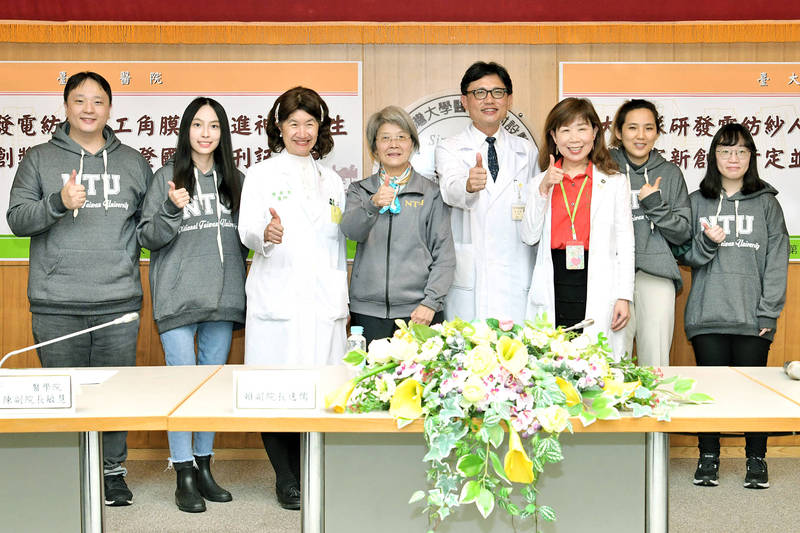《TAIPEI TIMES》NTUH unveils biomaterial to treat eyes

The codirectors of a National Taiwan University Hospital (NTUH) research team, Chen Wei-li, third right, a professor in NTUH’s Department of Ophthalmology, and Su Wei-fang, fifth right, a professor in National Taiwan University’s Department of Materials Science and Engineering, gesture alongside other members of the research team at a news conference in Taipei yesterday. Photo courtesy of the National Taiwan University Hospital
ELECTRO-SPUN MATERIAL: A research director said that intracorneal implantation of the tiny scaffolding in animals showed it facilitates corneal nerve regeneration
By Lee I-chia / Staff reporter
A research team has successfully developed an electro-spun biomaterial that can aid nerve regeneration in the eye, with animal studies demonstrating its effectiveness, National Taiwan University Hospital (NTUH) said yesterday.
The team used poly(gamma-benzyl-L-glutamate), or PBG — a fibrous scaffold — to develop a method to guide nerve growth and stimulate nerve regeneration, NTUH said, adding that the team won this year’s National Innovation Award.
The cornea, retina and optic nerve contain a lot of nerve tissue, and nerve damage is the most common reason for vision loss, NTUH’s Department of Ophthalmology said, adding that current methods to regenerate nerve cells and repair damaged optic nerves have limited effect.
The research team’s codirector, Chen Wei-li (陳偉勵), a professor in the ophthalmology department, said that the cornea has the highest nerve density of any tissue in the human body, so corneal nerve damage recovery is usually a lengthy process and sometimes the damage is permanent, while treatment costs are high.
The research team, consisting of members from the ophthalmology department, National Taiwan University’s (NTU) Department of Materials Science and Engineering, and Academia Sinica, spent seven years developing the electro-spun biomaterial, which can be used to build a biomimetic scaffold, Chen said.
Intracorneal implantation of PBG in animals showed that it can facilitate corneal nerve regeneration better than other artificial corneas, she said.
The PBG, which has built-in neurotransmitter glutamate, is synthesized and fabricated via electrospinning — a method to produce fibers that uses electric forces to manipulate charged threads on a tiny scale — into scaffolds, she said.
The aligned fibers guide the growth and extension of nerves, Chen said, adding that animal studies suggest the method can repair 80 to 90 percent of damaged nerves without side effects of inflammation or infection.
NTU Department of Materials Science and Engineering professor Su Wei-fang (林唯芳), another codirector of the research team, said that the biomaterial not only serves as a scaffold, but also releases glutamate to stimulate nerve regeneration.
The research team invented the biomaterial, while teams from Harvard University and the University of Colorado have sought to cooperate with it, Su said.
Glaucoma is a common eye condition that can lead to loss of vision, so hopefully the biomaterial would help people with the condition regain their vision, she said.
新聞來源:TAIPEI TIMES















